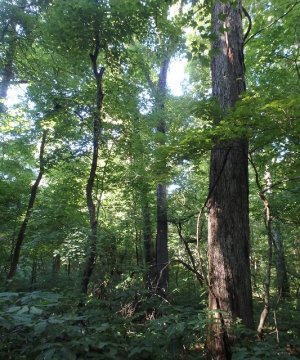Loamy Terrace Forest
Scenario model
Current ecosystem state
Select a state
Management practices/drivers
Select a transition or restoration pathway
-
No transition or restoration pathway between the selected states has been described
Target ecosystem state
Select a state
Description
The reference state was dominated by northern red oak and sugar maple including a wide variety of other deciduous hardwood tree species. Periodic disturbances from fire, wind or occurred along with infrequent flooding. Long disturbance-free periods allowed an increase in more shade tolerant species such as bitternut hickory and sugar maple. Two community phases are recognized in this state, with shifts between phases based on disturbance frequency.
The reference state is rare today. Some sites have been converted to grassland (State 4). Others have been subject to repeated, high-graded timber harvest coupled with uncontrolled domestic livestock grazing (State 5). Many reference sites have been managed for timber harvest, resulting in either even-age (State 2) or uneven-age (State 3) forests.
Submodel
Description
These former forests are now rather dense, with an under developed understory and ground flora. Thinning can increase overall tree vigor and improve understory diversity. Continual timber management, depending on the practices used, will either maintain this state, or convert the site to uneven-age (State 3) forests.
Submodel
Description
Uneven-Age Managed forests can resemble the reference state but are denser. The biggest differences are tree age, most being only 50 to 90 years old, and canopy closure. Composition is also likely altered from the reference state depending on tree selection during harvest. In addition, without a regular 15 to 20 year harvest re-entry into these stands, they will slowly increase in more shade tolerant species such as bitternut hickory and sugar maple and northern red oak will become less dominant.
Submodel
Description
Conversion of forests to planted, non-native pasture species such as tall fescue has been common in this MLRA. If grazing and active pasture management is discontinued, the site will eventually transition, over time, to State 2 (Even-Age).
Submodel
Description
Forested sites subjected to repeated, high-graded timber harvests and uncontrolled domestic grazing transition to this state. This state exhibits an over-abundance of hickory and other less desirable tree species, and weedy understory species such as coralberry, gooseberry, poison ivy and Virginia creeper. The vegetation offers little nutritional value for cattle, and excessive stocking damages tree boles, degrades understory species composition and results in soil compaction and accelerated erosion and runoff. Exclusion of livestock from sites in this state coupled with uneven-age management techniques will cause a transition to State 3 (Uneven-Age).
Submodel
Model keys
Briefcase
Add ecological sites and Major Land Resource Areas to your briefcase by clicking on the briefcase (![]() ) icon wherever it occurs. Drag and drop items to reorder. Cookies are used to store briefcase items between browsing sessions. Because of this, the number of items that can be added to your briefcase is limited, and briefcase items added on one device and browser cannot be accessed from another device or browser. Users who do not wish to place cookies on their devices should not use the briefcase tool. Briefcase cookies serve no other purpose than described here and are deleted whenever browsing history is cleared.
) icon wherever it occurs. Drag and drop items to reorder. Cookies are used to store briefcase items between browsing sessions. Because of this, the number of items that can be added to your briefcase is limited, and briefcase items added on one device and browser cannot be accessed from another device or browser. Users who do not wish to place cookies on their devices should not use the briefcase tool. Briefcase cookies serve no other purpose than described here and are deleted whenever browsing history is cleared.
Ecological sites
Major Land Resource Areas
The Ecosystem Dynamics Interpretive Tool is an information system framework developed by the USDA-ARS Jornada Experimental Range, USDA Natural Resources Conservation Service, and New Mexico State University.

